High-Energy Mode-Locked Pulse Er-Doped Fiber Laser-Based GeTe as Saturable Absorber
Abstract
:1. Introduction
2. Preparation and Characterization of GeTe SA
2.1. Crystal Model of GeTe
2.2. Characterization of GeTe
2.3. Preparation of GeTe SA
3. Experimental Setup
4. Experimental Results and Discussions
5. Conclusions
Author Contributions
Funding
Data Availability Statement
Conflicts of Interest
References
- Rashi, F.A.A.; Azzuhri, S.R.; Salim, M.A.M.; Shaharuddin, R.A.; Ismail, M.A.; Ismail, M.F.; Razak, M.Z.A.; Ahmad, H. Using a black phosphorus saturable absorber to generate dual wavelengths in a Q-switched ytterbium-doped fiber laser. Laser Phys. Lett. 2016, 13, 085102. [Google Scholar] [CrossRef] [Green Version]
- Shang, X.X.; Guo, L.G.; Zhang, H.N.; Li, D.W.; Yue, Q.Y. Titanium disulfide based saturable absorber for generating passively mode-locked and Q-switched ultra-fast fiber lasers. Nanomaterials 2020, 10, 1922. [Google Scholar] [CrossRef] [PubMed]
- Xu, N.N.; Sun, S.; Shang, X.X.; Zhang, H.N.; Li, D.W. Harmonic and fundamental-frequency mode-locked operations in an Er-doped fiber laser using a Cr2Si2Te6-based saturable absorber. Opt. Mater. Express 2022, 12, 166–173. [Google Scholar] [CrossRef]
- Shang, X.X.; Xu, N.N.; Zhang, H.N.; Li, D.W. Nonlinear photoresponse of high damage threshold titanium disulfide nanocrystals for Q-switched pulse generation. Opt. Laser Technol. 2022, 151, 107988. [Google Scholar] [CrossRef]
- Liu, S.C.; Wang, Y.G.; Lv, R.D.; Wang, J.; Wang, H.Z.; Wang, Y.; Duan, L.N. 2D molybdenum carbide (Mo2C)/fluorine mica (FM) saturable absorber for passively mode-locked erbium-doped all-fiber laser. Nanophotonics 2020, 9, 2523–2530. [Google Scholar] [CrossRef]
- Chen, B.; Zhang, X.Y.; Wu, K.; Wang, H.; Wang, J. Q-switched fiber laser based on transition metal dichalcogenides MoS2, MoSe2, WS2, and WSe2. Opt. Express 2015, 23, 26723–26737. [Google Scholar] [CrossRef]
- Du, J.; Wang, Q.K.; Jiang, G.B.; Xu, C.W.; Zhao, C.J.; Xiang, Y.J.; Chen, Y.; Wen, S.C.; Han, Z. Ytterbium-doped fiber laser passively mode locked by few-layer Molybdenum disulfide (MoS2) saturable absorber functioned with evanescent field interaction. Sci. Rep. 2014, 4, 6346. [Google Scholar] [CrossRef] [Green Version]
- Luo, Z.C.; Liu, M.; Liu, H.; Zheng, X.W.; Luo, A.P.; Zhao, C.J.; Zhang, H.; Wen, S.C.; Xu, W.C. 2 GHz passively harmonic mode-locked fiber laser by a microfiber-based topological insulator saturable absorber. Opt. Lett. 2013, 38, 5212–5215. [Google Scholar] [CrossRef]
- Zhao, C.J.; Zou, Y.H.; Chen, Y.; Wang, Z.T.; Tang, D.Y. Wavelength-tunable picosecond soliton fiber laser with Topological Insulator: Bi2Se3 as a mode locker. Opt. Express 2013, 20, 27888–27895. [Google Scholar] [CrossRef]
- Guo, B.; Yao, Y.; Yang, Y.F.; Yuan, Y.J.; Jin, L.; Yan, B.; Zhang, J.Y. Dual-wavelength rectangular pulse erbium-doped fiber laser based on topological insulator saturable absorber. Photonics Res. 2015, 3, 94–99. [Google Scholar] [CrossRef] [Green Version]
- Gusev, G.M.; Kvon, Z.D.; Shegai, O.A.; Mikhailov, N.N.; Dvoretsky, S.A.; Portal, J.C. Transport in disordered two-dimensional topological insulator. Phys. Rev. B 2011, 84, 121302. [Google Scholar] [CrossRef] [Green Version]
- Hu, N.N.; Zhang, H.N.; Man, B.Y. Various large-energy soliton operations within an Er-doped fiber laser with bismuth selenide as a saturable absorber. Appl. Opt. 2018, 57, 8811–8818. [Google Scholar]
- Zhang, H.; Bao, Q.L.; Tang, D.Y.; Zhao, L.M.; Loh, K.P. Large energy soliton erbium-doped fiber laser with a graphene-polymer composite mode locker. Appl. Phys. Lett. 2009, 95, 141103. [Google Scholar] [CrossRef] [Green Version]
- Li, F.; Zhao, W.; Wang, Y.S.; Li, D.J.; Song, D.D.; Li, Q.L.; Yang, Y.; Wen, W.L. Large dispersion-managed broadband high-energy fiber femtosecond laser system with sub 300 fs pulses and high beam quality output. Opt. Laser Technol. 2023, 157, 108653. [Google Scholar] [CrossRef]
- Li, X.H.; Liu, X.M.; Hu, X.H. Long-cavity passively mode-locked fiber ring laser with high-energy rectangular-shape pulses in anomalous dispersion regime. Opt. Lett. 2010, 35, 3249–3251. [Google Scholar] [CrossRef]
- Li, L.; Pang, L.H.; Wang, R.F.; Zhang, X.G.; Hui, Z.Q.; Han, D.D.; Zhao, F.; Liu, W.J. Ternary Transition Metal Dichalcogenides for High Power Vector Dissipative Soliton Ultrafast Fiber Laser. Laser Photonics Rev. 2022, 16, 2100255. [Google Scholar] [CrossRef]
- Xu, N.N.; Ma, P.F.; Fu, S.G.; Shang, X.X.; Jiang, S.Z.; Wang, S.Y.; Li, D.W.; Zhang, H.N. Tellurene-based saturable absorber to demonstrate large-energy dissipative soliton and noise-like pulse generations. Nanophotonics 2020, 9, 2783–2795. [Google Scholar] [CrossRef] [Green Version]
- Xu, N.N.; Ming, N.; Han, X.L.; Man, B.Y.; Zhang, H.N. Large-energy passively Q-switched Er-doped fiber laser based on CVD-Bi2Se3 as saturable absorber. Opt. Mater. Express 2019, 9, 373–383. [Google Scholar] [CrossRef]
- Han, X.L.; Zhang, H.N.; Jiang, S.Z.; Zhang, C.; Li, D.W.; Guo, Q.X.; Gao, J.J.; Man, B.Y. Improved Laser Damage Threshold of In2Se3 Saturable Absorber by PVD for High-Power Mode-Locked Er-Doped Fiber Laser. Nanomaterials 2019, 9, 1216. [Google Scholar] [CrossRef] [Green Version]
- Fu, S.G.; Li, J.J.; Zhang, S.S.; Bai, Z.D.; Wu, T.G.; Man, Z.S. Large-energy mode-locked Er-doped fiber laser based on indium selenide as a modulator. Opt. Mater. Express 2019, 9, 2662. [Google Scholar] [CrossRef]
- Zhu, M.X.; Yang, F.H.; Sun, S.; Chen, S.; Wang, Y.J.; Sui, Z.Q.; Hong, Z.F.; Wang, G.M.; Zhang, W.F.; Zhang, H.H.; et al. Large-energy mode-locked Er-doped fiber laser based Cr2Si2Te6 as a modulator. Infrared Phys. Technol. 2021, 119, 103941. [Google Scholar] [CrossRef]
- Okhotnikov, O.; Grudinin, A.; Pessa, M. Ultra-fast fibre laser systems based on SESAM technology: New horizons and applications. New J. Phys. 2004, 6, 177. [Google Scholar] [CrossRef]
- Sotor, J.; Sobon, G.; Macherzynski, W.; Paletko, P.; Abramski, K.M. Black phosphorus saturable absorber for ultrashort pulse generation. Appl. Phy. Lett. 2015, 107, 051108. [Google Scholar] [CrossRef] [Green Version]
- Xu, Y.J.; Shi, Z.; Shi, X.Y.; Zhang, K.; Zhang, H. Recent progress in black phosphorus and black-phosphorus-analogue materials: Properties, synthesis and applications. Nanoscale 2019, 11, 14491–14527. [Google Scholar] [CrossRef] [PubMed]
- Niu, K.D.; Chen, Q.Y.; Sun, R.Y.; Man, B.Y.; Zhang, H.N. Passively Q-switched erbium-doped fiber laser based on SnS2 saturable absorber. Opt. Mater. Express 2017, 7, 3934–3943. [Google Scholar] [CrossRef]
- Orchin, G.J.; Fazio, D.D.; Bernardo, A.D.; Hamer, M.; Yoon, D.; Cadore, A.R.; Goykhman, I.; Watanabe, K.; Taniguchi, T.; Robinson, J.W.A.; et al. Niobium diselenide superconducting photodetectors. Appl. Phys. Lett. 2019, 114, 251103. [Google Scholar] [CrossRef] [Green Version]
- Li, Z.Q.; Dong, N.N.; Zhang, Y.X.; Wang, J.; Yu, H.H.; Chen, F. Mode-locked waveguide lasers modulated by rhenium diselenide as a new saturable absorber. APL Photonics 2018, 3, 080802. [Google Scholar] [CrossRef] [Green Version]
- Lan, D.F.; Cheng, T.L.; Qu, Y.H.; Zhang, X.N.; Yan, X.; Suzuki, T.; Ohishi, Y.; Wang, F. Tungsten Carbide Nanoparticles as Saturable Absorber for Q-Switched Erbium-Doped Fiber Laser. IEEE Photonics Technol. Lett. 2022, 34, 113–116. [Google Scholar] [CrossRef]
- Wang, X.D.; Luo, Z.C.; Liu, H.M.; Luo, A.P.; Xu, W.C. Microfiber-based gold nanorods as saturable absorber for femtosecond pulse generation in a fiber laser. Appl. Phys. Lett. 2014, 105, 161107. [Google Scholar] [CrossRef]
- Zhang, M.; Kelleher, E.; Torrisi, F.; Sun, Z.; Hasan, T.; Popa, D.; Wang, F.; Ferrari, A.C.; Popov, S.V.; Taylor, J.R. Tm-doped fiber laser mode-locked by graphene-polymer composite. Opt. Express 2012, 20, 25077–25084. [Google Scholar] [CrossRef] [Green Version]
- Jiang, Z.K.; Chen, H.; Li, J.R.; Yin, J.D.; Wang, J.Z.; Yan, P.G. 256 fs, 2 nJ soliton pulse generation from MoS2 mode-locked fiber laser. Appl. Phys. Express 2017, 10, 122702. [Google Scholar] [CrossRef]
- Yang, S.; Yang, Y.Y.; Zhang, L.; Huang, J.Y.; Bai, Y.R.; Lin, X.C. 25 nJ, 634 ps and 1 MHz all-fiber passively mode-locked fiber laser based on a GaAs saturable absorber. Optik 2019, 178, 1218–1222. [Google Scholar] [CrossRef]
- Luo, Z.Q.; Zhou, M.; Weng, J.; Huang, G.M.; Xu, H.Y.; Ye, C.C.; Cai, Z.P. Graphene-based passively Q-switched dual-wavelength erbium-doped fiber laser. Opt. Lett. 2010, 35, 3709–3711. [Google Scholar] [CrossRef] [PubMed] [Green Version]
- Chen, Y.; Zhao, C.J.; Chen, S.Q.; Du, J.; Tang, P.H.; Jiang, G.B.; Tang, D.Y. Large energy, wavelength widely tunable, topological insulator Q-switched erbium-doped fiber laser. IEEE J. Quantum Electron. 2014, 20, 315–322. [Google Scholar] [CrossRef]
- Baranava, M.S.; Hvazdouski, D.C.; Skachkova, V.A.; Stempitsky, V.R.; Danilyuk, A.L. Magnetic interactions in Cr2Ge2Te6 and Cr2Si2Te6 monolayers: Ab initio study. Mater. Today Proc. 2020, 20, 342–347. [Google Scholar] [CrossRef]
- Wang, G.M.; Zhang, W.F.; Han, K.Z.; Xing, F.; Zhang, H.N.; Fu, S.G. Q-switched dissipative soliton resonance operation in GeTe based fiber laser. Infrared Phys. Technol. 2021, 116, 103806. [Google Scholar] [CrossRef]
- Wang, G.M.; Zhang, W.F.; Han, K.Z.; Lu, C.; Zhang, H.N.; Fu, S.G. GeTe based modulator for the generation of soliton, soliton molecule and bright-dark soliton pair. Infrared Phys. Technol. 2022, 125, 104304. [Google Scholar] [CrossRef]
- Guo, D.L.; Li, C.H.; Qiu, K.B.; Yang, Q.Q.; Li, K.J.; Shao, B.; Chen, D.M.; Ma, Y.L.; Sun, J.C.; Cao, X.L.; et al. The n- and p-type thermoelectricity property of GeTe by first-principles study. J. Alloys Compd. 2019, 810, 151838. [Google Scholar] [CrossRef]
- Levin, E.M.; Besser, M.F.; Hanus, R. Electronic and thermal transport in GeTe: A versatile base for thermoelectric materials. J. Appl. Phys. 2013, 114, 083713. [Google Scholar] [CrossRef]
- Cui, J.; Li, S.S.; Xia, C.X.; Chen, Y.; He, J.Q. Pressure effects on the electrical transport and anharmonic lattice dynamics of r-GeTe: A first-principles study. J. Mater. 2021, 7, 1190–1197. [Google Scholar] [CrossRef]
- Dong, J.F.; Sun, F.H.; Tang, C.; Pei, J.; Zhuang, H.L.; Hu, H.H.; Zhang, B.P.; Pan, Y.; Li, J.F. Medium-temperature thermoelectric GeTe: Vacancy suppression and band structure engineering leading to high performance. Energy Environ. Sci. 2019, 4, 1396–1403. [Google Scholar] [CrossRef]
- Zhang, P.P.; Zhao, F.L.; Long, P.; Wang, Y.; Yue, Y.C.; Liu, X.Y.; Feng, Y.Y.; Li, R.J.; Hu, W.P.; Li, Y.; et al. Sonication-assisted liquid-phase exfoliated α-GeTe: A two-dimensional material with high Fe3 sensitivity. Nanoscale 2018, 34, 15989–15997. [Google Scholar] [CrossRef] [PubMed]
- Liu, W.D.; Wang, D.Z.; Liu, Q.F.; Zhou, W.; Shao, Z.P.; Chen, Z.G. High-Performance GeTe-Based Thermoelectrics: From Materials to Devices. Adv. Energy Mater. 2020, 10, 2000367. [Google Scholar] [CrossRef]
- Cheng, L.; Yuan, Y.F.; Liu, C.M.; Cao, X.R.; Su, J.; Zhang, X.T.; Zhang, H.; Zhao, H.B.; Xu, M.; Li, J. Linear and nonlinear optical properties modulation of Sb2Te3/GeTe bilayer film as a promising saturable absorber. Results Phys. 2019, 13, 102282. [Google Scholar] [CrossRef]
- Sheng, Q.Y.; Tang, S.Q.; Ye, F.M.; Wang, Y.J.; Chen, S.; Bai, C.X.; Lu, C.; Zhang, H.N.; Fu, S.G.; Wang, G.M.; et al. Passively mode-locked fiber laser based on GeTe as a saturable absorber. Appl. Opt. 2022, 61, 9379–9385. [Google Scholar] [CrossRef]
- Haus, H.A. Mode-locking of lasers. IEEE J. Sel. Top. Quantum Electron. 2000, 6, 1173–1185. [Google Scholar] [CrossRef]
- Zheng, X.W.; Luo, Z.C.; Liu, H.; Zhao, N.; Ning, Q.Y.; Liu, M.; Feng, X.H.; Xing, X.B.; Luo, A.P.; Xu, W.C. High-energy noiselike rectangular pulse in a passively mode-locked figure-eight fiber laser. Appl. Phys. Express 2014, 7, 042701. [Google Scholar] [CrossRef]
- Wang, X.F.; Xia, Q.; Gu, B. A 1.9 μm noise-like mode-locked fiber laser based on compact figure-9 resonator. Opt. Commun. 2018, 18, 30933. [Google Scholar] [CrossRef]
- Ma, P.F.; Lin, W.; Zhang, H.N.; Xu, S.H.; Yang, Z.M. High-Power Large-Energy Rectangular Mode-Locked Er-Doped Fiber Laser Based on High-Damage-Threshold MoS2 Saturable Absorber. IEEE Photon. 2019, 11, 1504312. [Google Scholar]
- Wei, Q.; Niu, K.G.; Han, X.L.; Zhang, H.N.; Zhang, C.; Yang, C.; Man, B.Y. Large energy pulses generation in a mode-locked Er-doped fiber laser based on CVD-grown Bi2Te3 saturable absorber. Opt. Mater. Express 2019, 9, 3535. [Google Scholar] [CrossRef]
- Sui, Z.Q.; Yang, F.H.; Han, Y.A.; Fan, W.Y.; Li, S.M.; Bai, C.X.; Lu, C.; Zhang, W.F.; Wang, G.M.; Fu, S.G.; et al. Large energy mode-locked phenomenon based on ZrS2 in Er-doped fiber laser. Opt. Laser Technol. 2023, 157, 108723. [Google Scholar] [CrossRef]
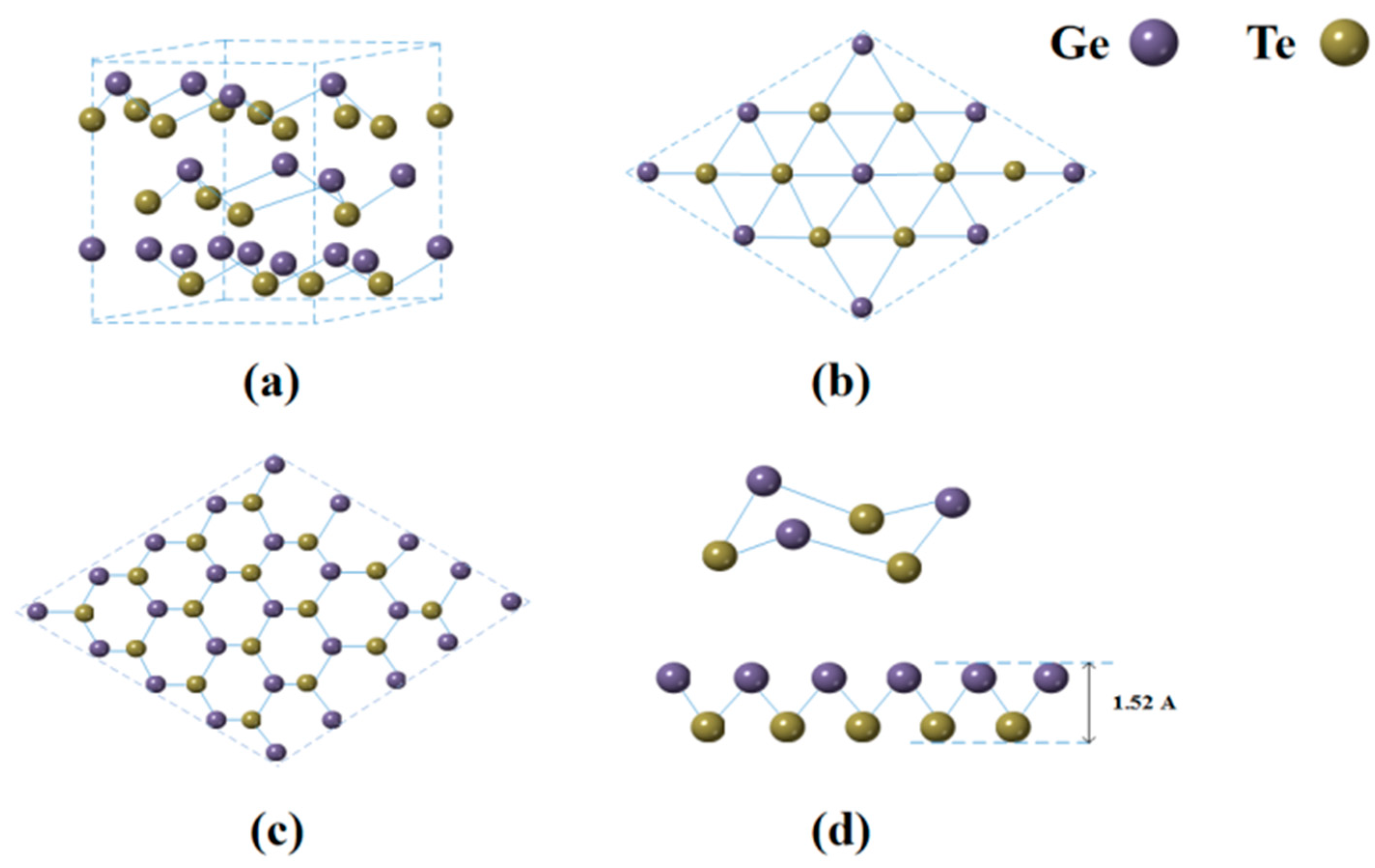
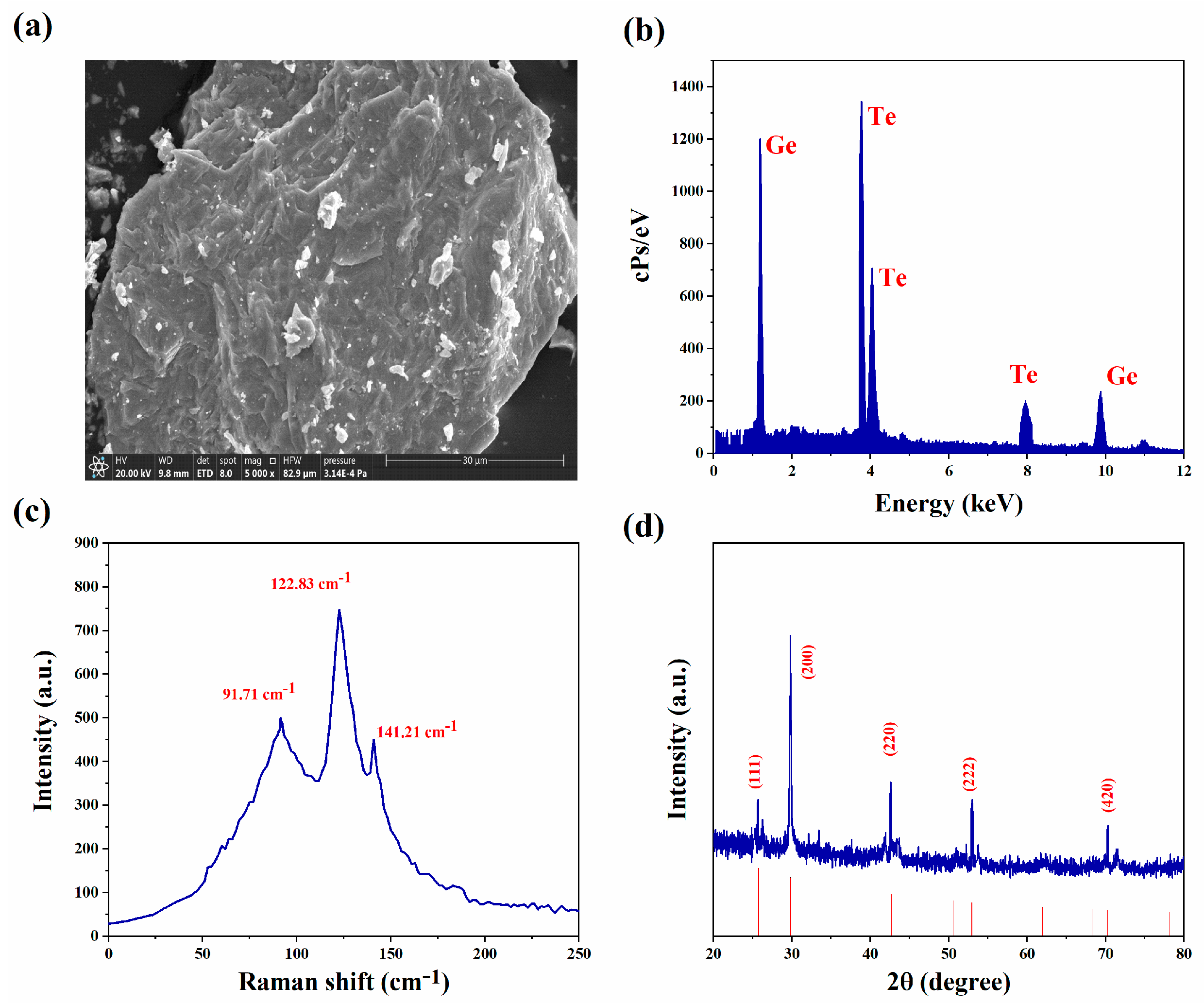
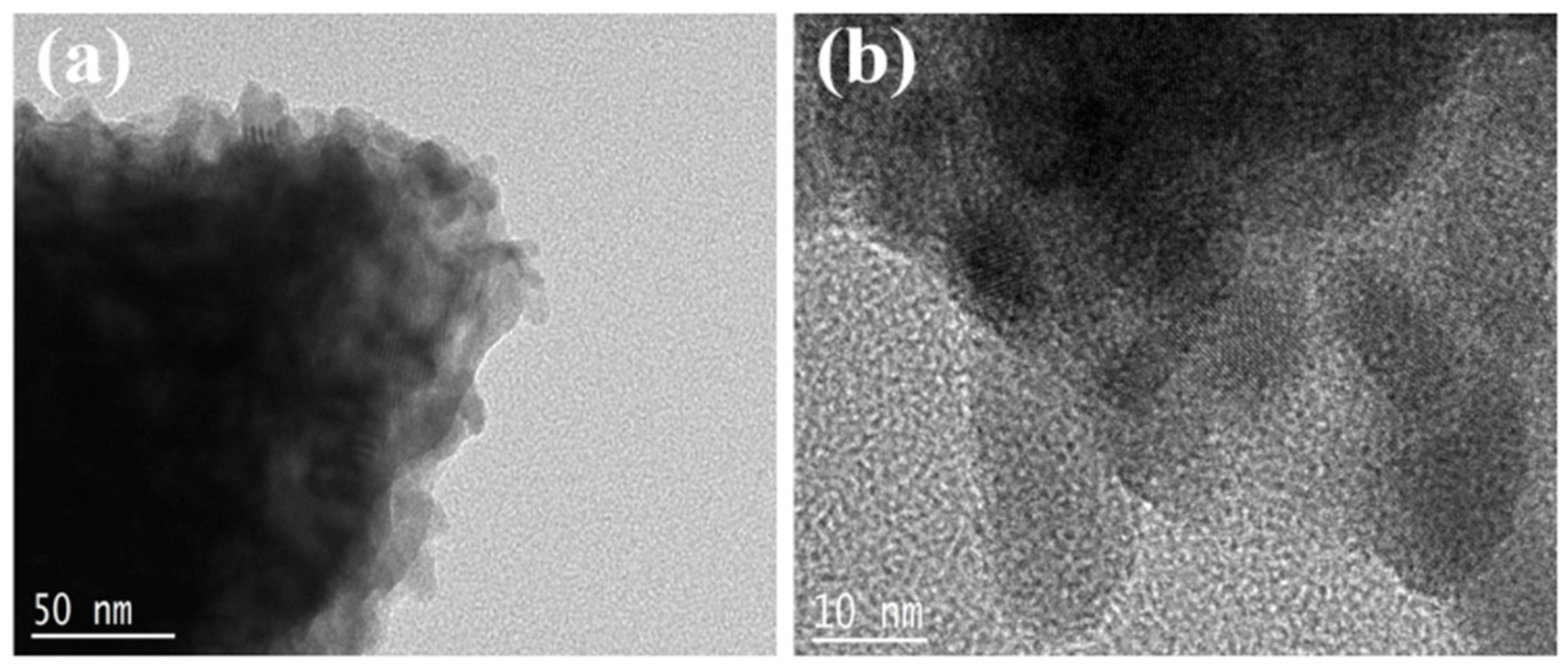
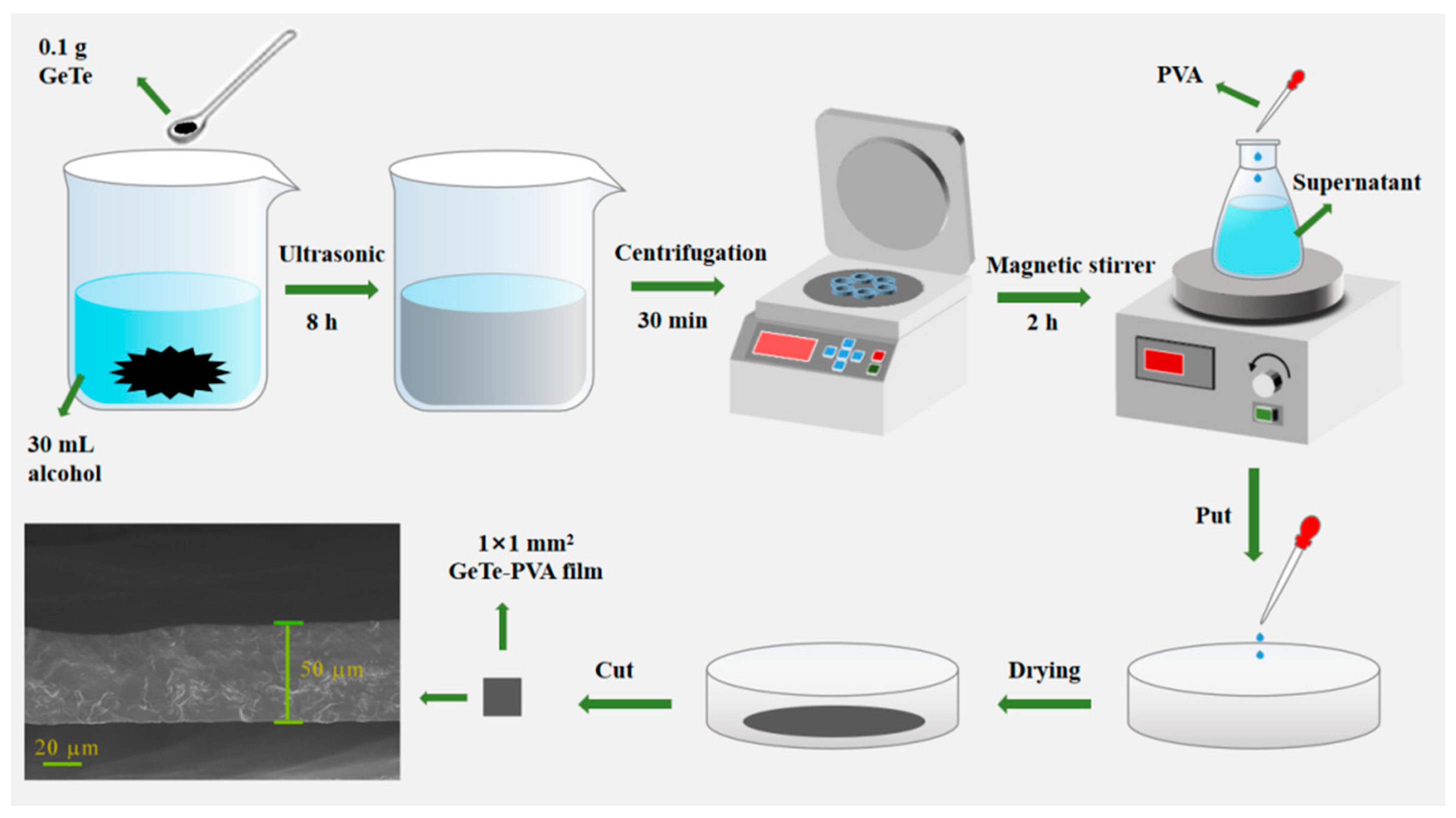
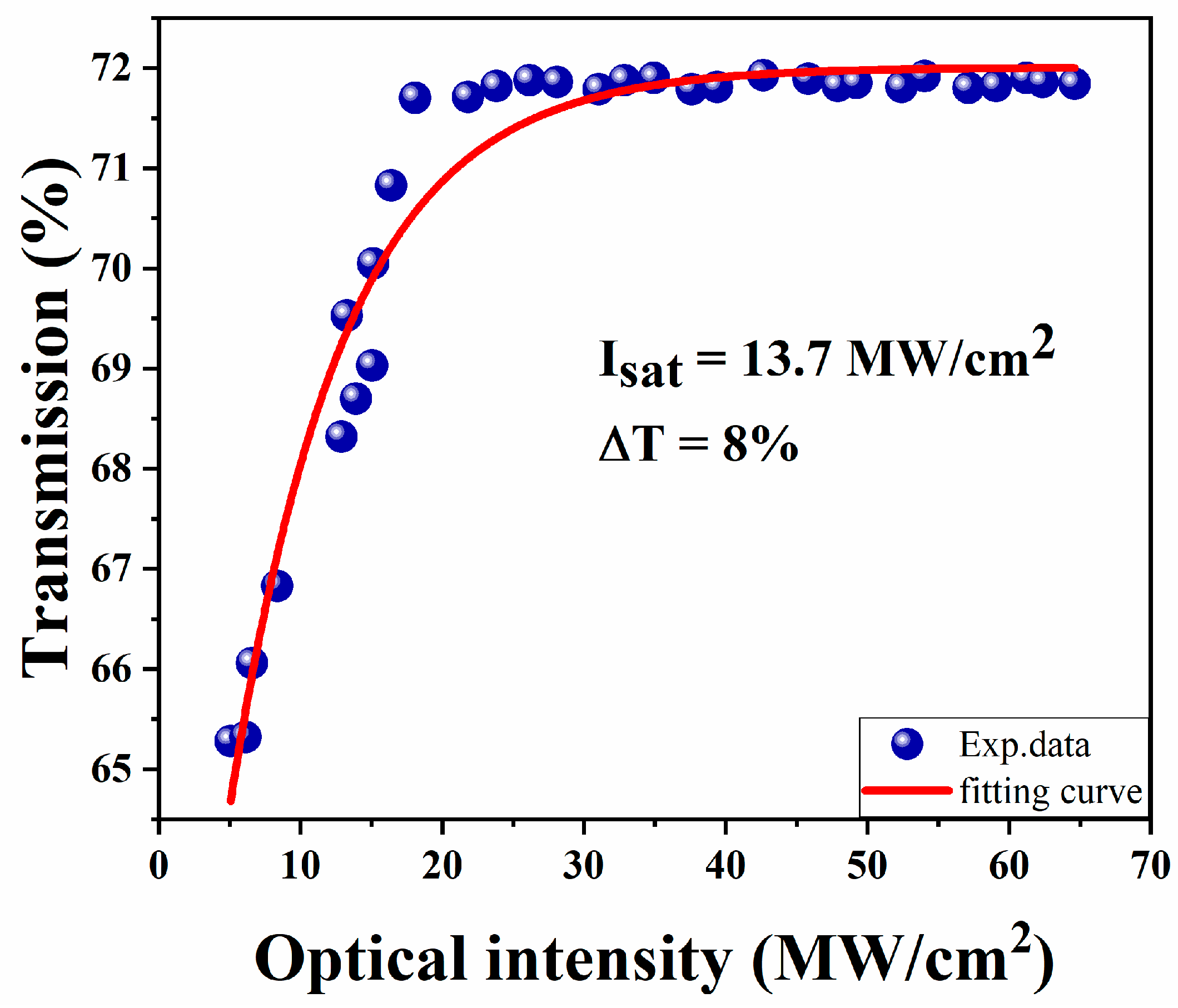
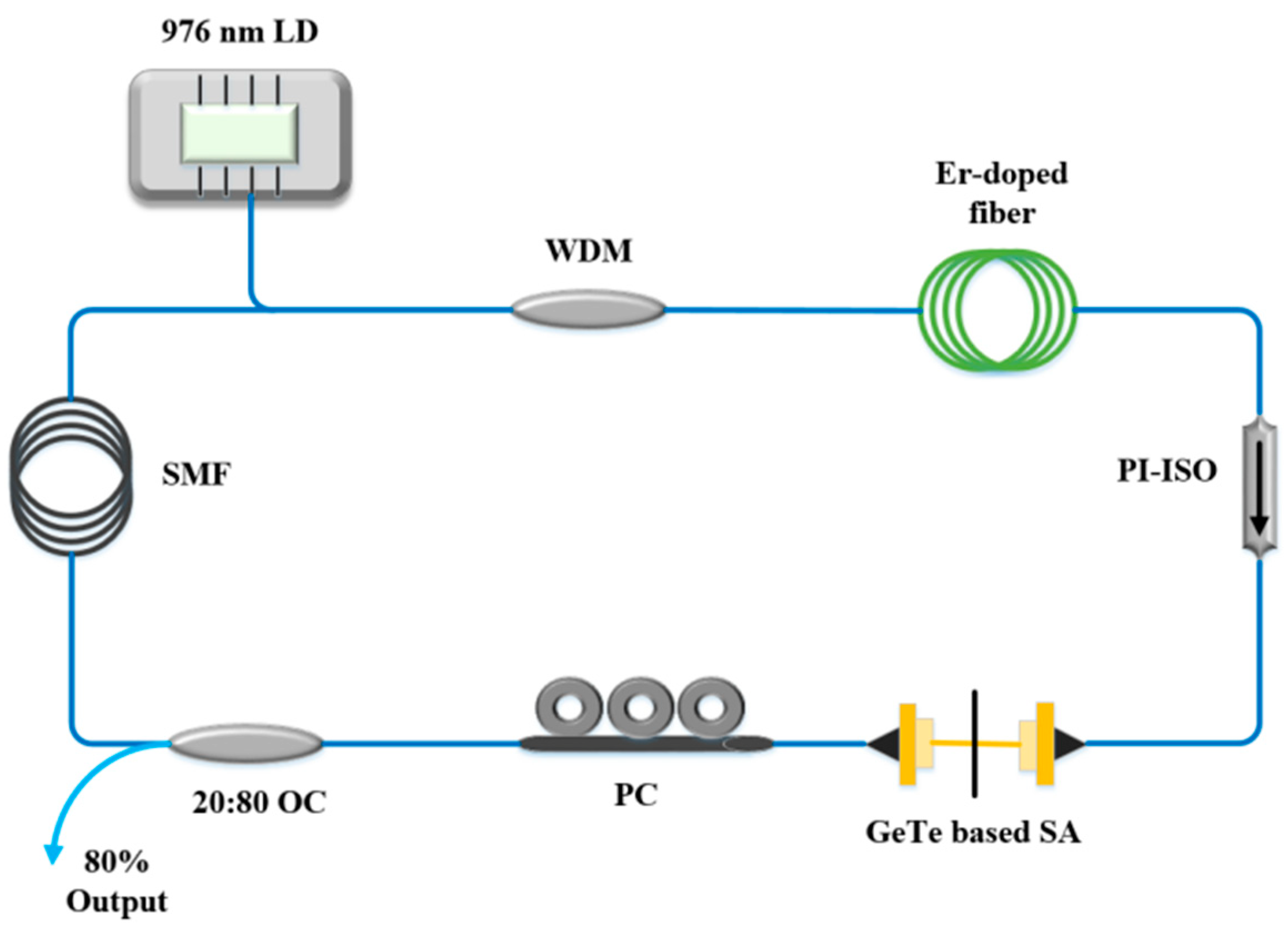

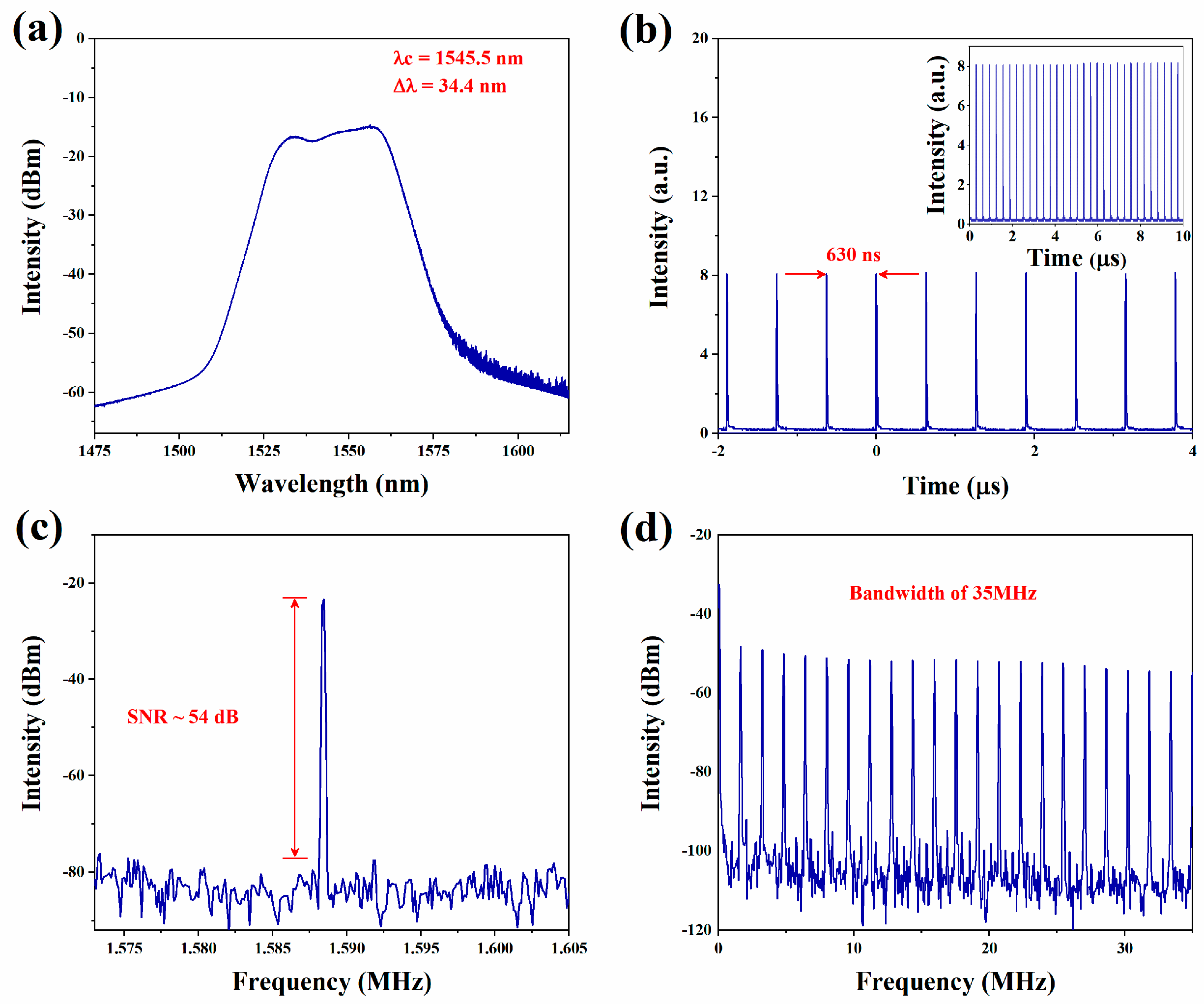
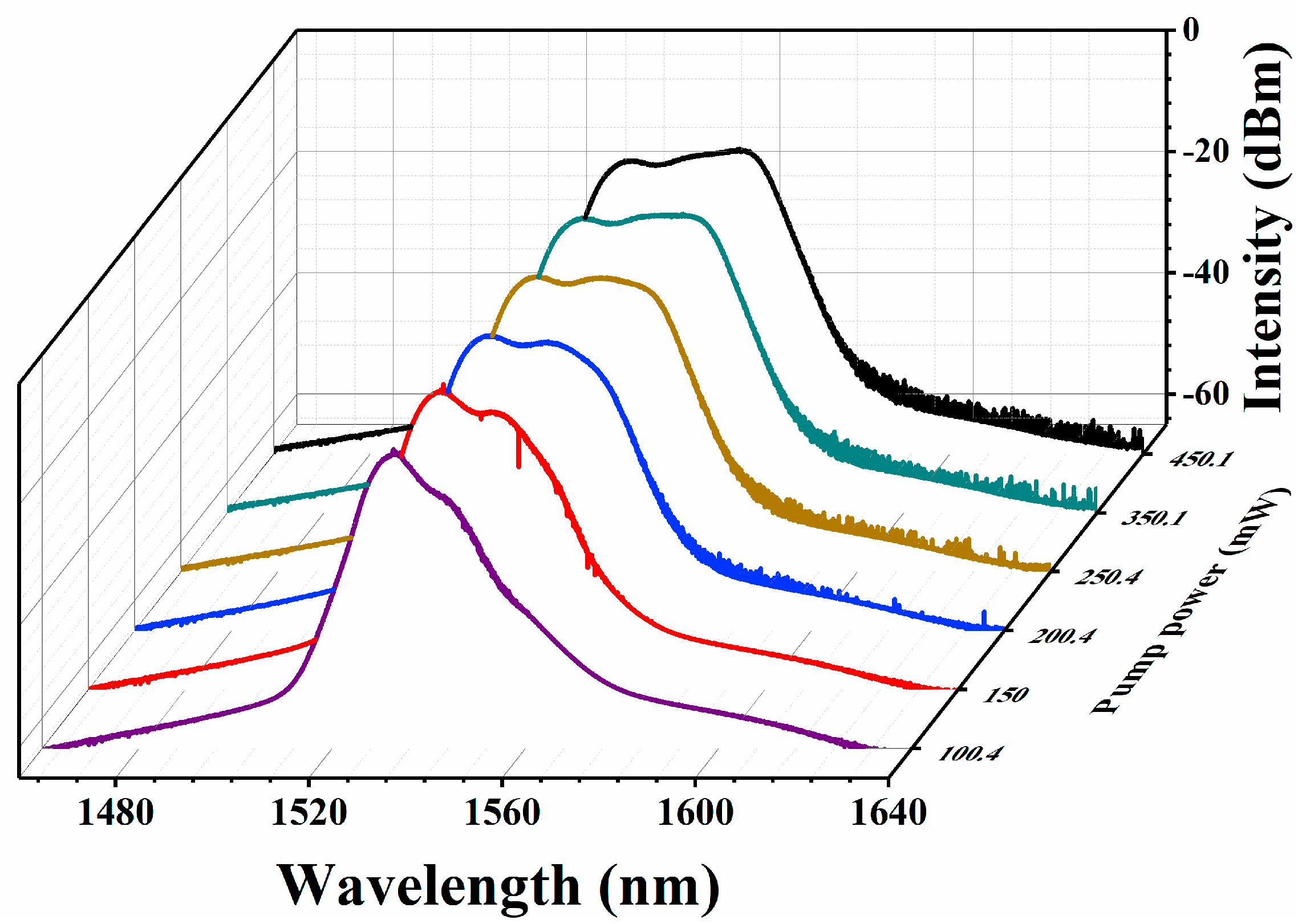
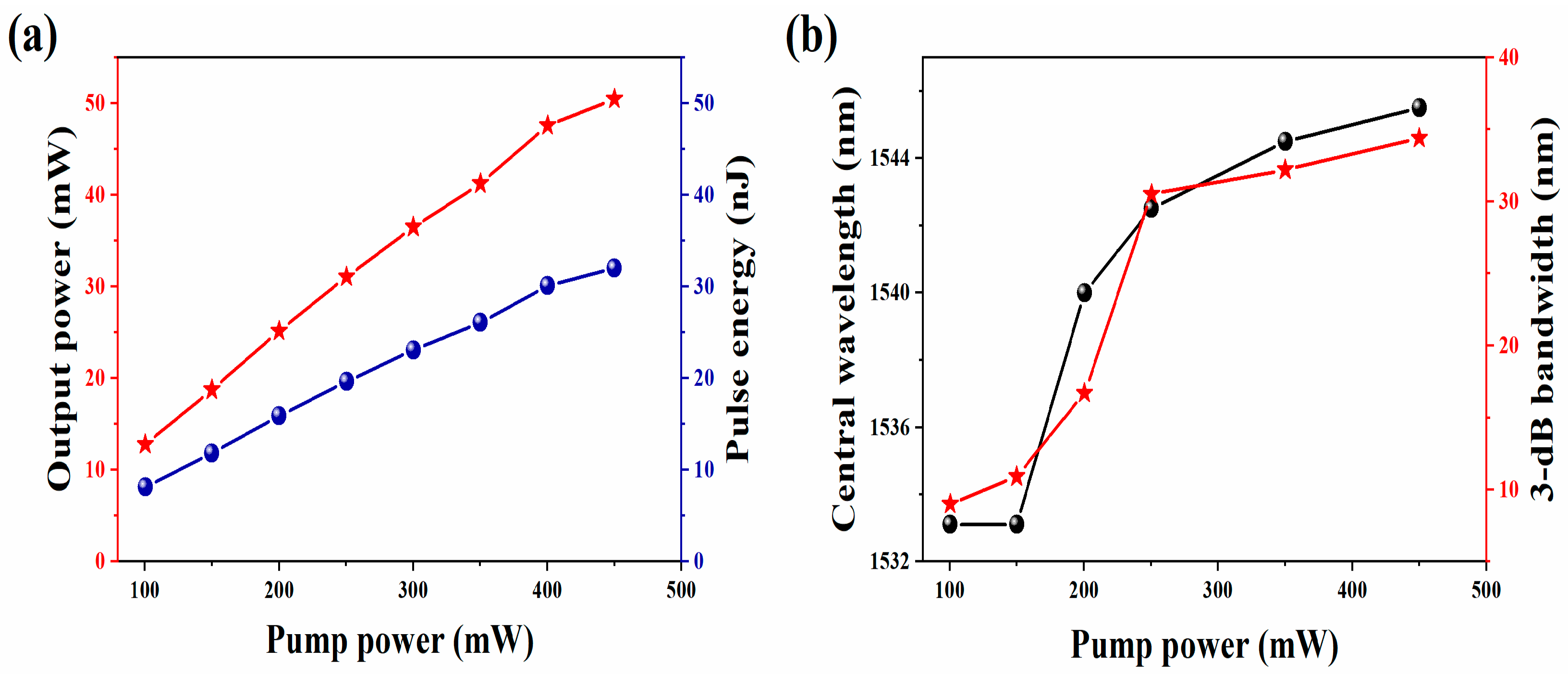
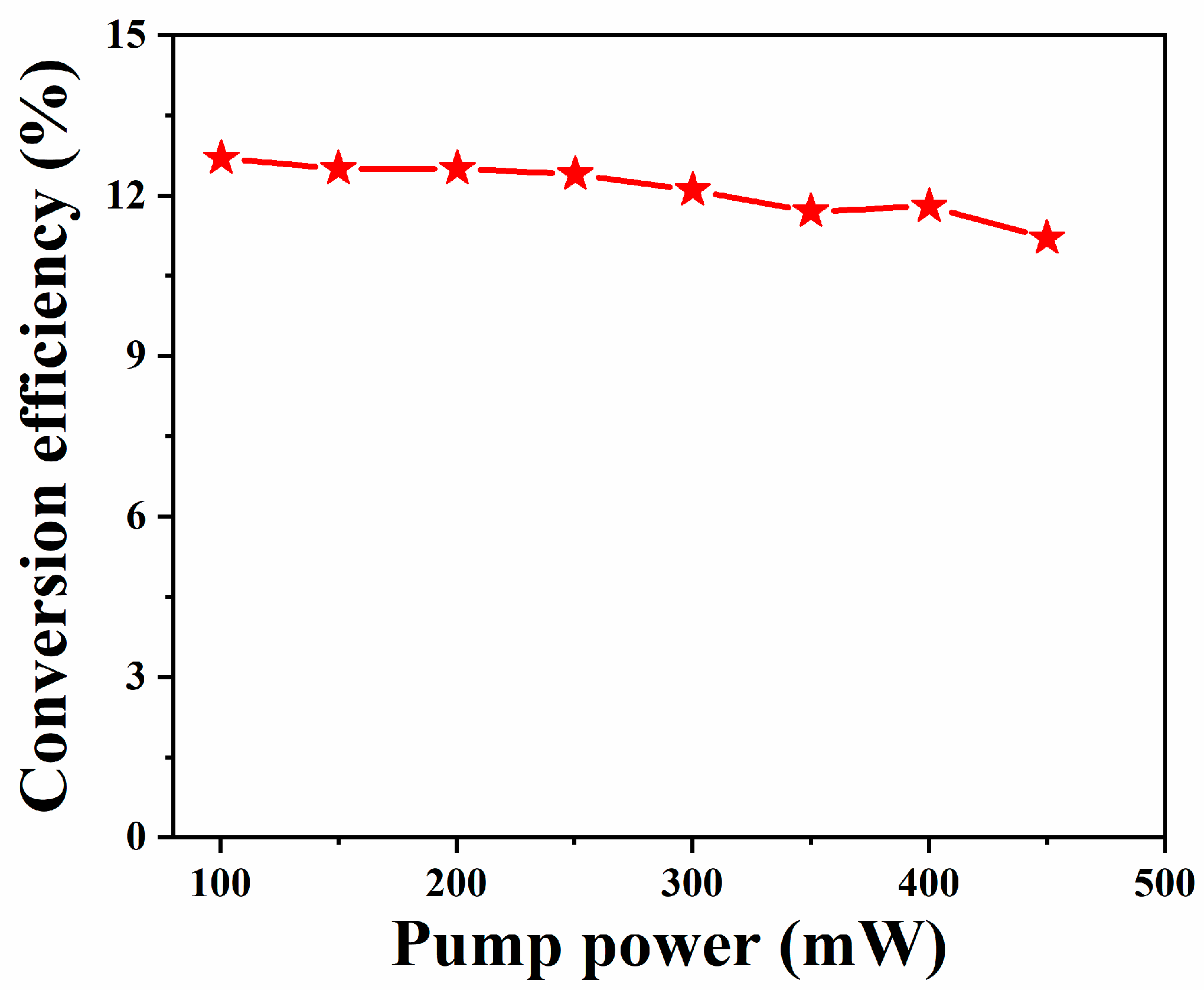
| Optical Pulse Output Ratio (%) | Pulse Splitting Threshold (mW) | Maximum Single-Pulse Energy (nJ) | Conversion Efficiency (%) |
|---|---|---|---|
| 20 | 400.2 | 10.69 | 4.1 |
| 40 | 520.4 | 16.7 | 4.9 |
| 70 | 470 | 26.05 | 8.6 |
| 80 | 450.1 | 32 | 11.2 |
| 90 | 420.3 | 13.78 | 5.1 |
| SAs | Pump Power (mW) | Wavelength (nm) | SNR(dB) | Pulse Duration (ns) | Output Power (mW) | Pulse Energy (nJ) | Conversion Efficiency (%) | Reference |
|---|---|---|---|---|---|---|---|---|
| tellurene | 1120 | 1563.97 | 55 | 0.059 | 106.6 | 8.76 | 9.25 | [17] |
| In2Se3 | 1324 | 1559.4 | 42 | 14.4 | 122.4 | 5.8 | 9.24 | [19] |
| InSe | 560 | - | 45 | 389.2 | 11.96 | 20.4 | 2.13 | [20] |
| MoS2 | 1725 | 1564.58 | 50 | 10.84 | 122.77 | 130.49 | 7.1 | [49] |
| Bi2Te3 | 659 | 1558.459 | 50 | 3.22 | 40.7 | 23.9 | 6.17 | [50] |
| ZrS2 | 1250 | 1531 | / | 181 | 14.19 | 23.65 | 1.14 | [51] |
| GeTe | 450.1 | 1545.5 | 54 | 8.3 | 50.48 | 32 | 11.22 | Ours |
Disclaimer/Publisher’s Note: The statements, opinions and data contained in all publications are solely those of the individual author(s) and contributor(s) and not of MDPI and/or the editor(s). MDPI and/or the editor(s) disclaim responsibility for any injury to people or property resulting from any ideas, methods, instructions or products referred to in the content. |
© 2023 by the authors. Licensee MDPI, Basel, Switzerland. This article is an open access article distributed under the terms and conditions of the Creative Commons Attribution (CC BY) license (https://creativecommons.org/licenses/by/4.0/).
Share and Cite
Tang, S.; Sheng, Q.; Ye, F.; Li, Q.; Xiong, S.; Bai, C.; Lu, C.; Zhang, H.; Wang, G.; Zhang, W. High-Energy Mode-Locked Pulse Er-Doped Fiber Laser-Based GeTe as Saturable Absorber. Nanomaterials 2023, 13, 2331. https://doi.org/10.3390/nano13162331
Tang S, Sheng Q, Ye F, Li Q, Xiong S, Bai C, Lu C, Zhang H, Wang G, Zhang W. High-Energy Mode-Locked Pulse Er-Doped Fiber Laser-Based GeTe as Saturable Absorber. Nanomaterials. 2023; 13(16):2331. https://doi.org/10.3390/nano13162331
Chicago/Turabian StyleTang, Shouqian, Qiuyan Sheng, Faming Ye, Qi Li, Siyuan Xiong, Caixun Bai, Cheng Lu, Huanian Zhang, Guomei Wang, and Wenfei Zhang. 2023. "High-Energy Mode-Locked Pulse Er-Doped Fiber Laser-Based GeTe as Saturable Absorber" Nanomaterials 13, no. 16: 2331. https://doi.org/10.3390/nano13162331





